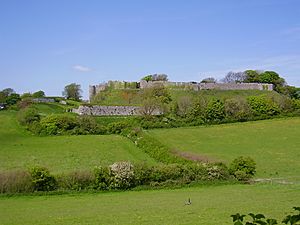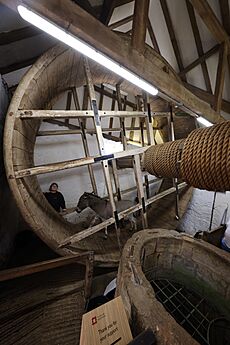Carisbrooke Castle facts for kids
Quick facts for kids Carisbrooke Castle |
|
|---|---|
| Carisbrooke, Isle of Wight, England | |

The interior of Carisbrooke Castle
|
|
| Coordinates | 50°41′15″N 1°18′48″W / 50.6874°N 1.3133°W |
| Grid reference | grid reference SZ486877 |
| Type | Castle |
| Site information | |
| Owner | Managed by English Heritage |
| Open to the public |
Yes |
| Condition | Complete |
| Site history | |
| Built | Begun in 12th century |
| In use | Until 1944 |
| Garrison information | |
| Past commanders |
Sir Nicholas Wadham (died 1542) Captain of the Isle of Wight, 1509–1520 |
| Occupants | Isabella de Fortibus, Charles I of England (imprisoned), Princess Beatrice of the United Kingdom |
Carisbrooke Castle is a very old castle found in the village of Carisbrooke on the Isle of Wight, England. It's famous because King Charles I was held prisoner here before his trial in 1649. Today, it's a popular place to visit and learn about history.
Contents
A Look Back: Early History
The land where Carisbrooke Castle stands might have been used even before the Romans arrived. There are signs of an old building from Roman times. The Anglo-Saxon Chronicle mentions that a person named Wihtgar was buried here in AD 544.
Later, in the 8th century, the Anglo-Saxons built a strong fort on the site. Around the year 1000, a wall was added around the hill to protect against Viking raids.
The Castle Through the Ages
From the 1100s, the castle belonged to the family of Richard de Redvers. Over the next 200 years, his family made the castle much stronger. They added stone walls, towers, and a tall central tower called a keep.
In 1293, Countess Isabella de Fortibus, the last Redvers owner, sold the castle to King Edward I. After that, kings and queens appointed special people called wardens to look after it.
Attacks and New Defenses
In 1377, during the time of King Richard II, the French tried to attack the castle but failed. A local hero, Peter de Heyno, is said to have saved it by shooting the French leader.
Later, in 1467, Anthony Woodville became the castle's owner. He added the Woodville Gate, which is now the main entrance. When Queen Elizabeth I was on the throne, she worried about the Spanish Armada (a large Spanish fleet). So, she had more defenses built around the castle.
An Italian engineer named Federigo Giambelli designed these new defenses. Starting in 1597, he built strong, low walls and ditches with powerful bastions (parts of the wall that stick out). These new defenses completely surrounded the older castle. Most of this work was finished by 1600.
Royal Prisoners and Residents
King Charles I was held prisoner at Carisbrooke Castle for 14 months before he was executed in 1649. After his death, his two youngest children were also kept there. Sadly, his daughter, Princess Elizabeth, died at the castle.
Much later, from 1896 to 1944, Princess Beatrice, who was Queen Victoria's daughter, lived at the castle. She was the Governor of the Isle of Wight. Today, English Heritage looks after the castle, and it is open for everyone to visit.
In 2007, English Heritage even opened a holiday apartment inside the castle for people to stay in! In 2019, over 131,000 people visited Carisbrooke Castle.
What You Can See at the Castle
Carisbrooke was the strongest castle on the Isle of Wight. Even though you can see it from far away, it doesn't stand out as much as some other castles.
You can still see hints of a Roman fort under the later buildings. If you're feeling energetic, you can climb 71 steps up to the top of the keep!
The main buildings inside the castle are from the 13th century, with some parts added in the 16th century. Some are now ruins, but the main rooms were used by the Governor of the Isle of Wight until the 1940s. These rooms are still in good condition.
You can visit the Great Hall, the Great Chamber, and other smaller rooms. There's also a museum upstairs that tells the story of the Isle of Wight. Many of the rooms have some furniture to show what they might have looked like.
A big part of the museum is about King Charles I. You can learn about his time as a prisoner and how he tried to escape in 1648, but couldn't fit through the window bars!
Interestingly, a city in New Zealand called Dunedin has a famous sports stadium named "Carisbrook." This name came from a visit to Carisbrooke Castle by one of Dunedin's founders.
The Main Gate
The impressive gateway tower was built by Lord Scales in 1464, who was in charge of the castle at that time.
The Chapel
The chapel, called St Nicholas in Castro, is right next to the main gate. It was rebuilt and reopened in 1904 as a special memorial to King Charles I. Inside the castle walls, there's a well that is 200 feet deep! Another well in the center of the keep is said to have been even deeper.
The Well-House
Near the main buildings, you'll find the well-house. This is where a special donkey wheel is used to pull water up from the deep well. Donkeys still work the wheel today, which is a fun thing to see! The well is also famous from the adventure book Moonfleet, where a diamond was hidden there.
The Constable's Chamber
The Constable's Chamber is a large room in the older part of the castle. This was King Charles I's bedroom when he was imprisoned. Later, Princess Beatrice used it as her dining room. Today, you can see King Charles I's bed here, along with Princess Beatrice's collection of stag and antelope heads.
Earthworks
All around the castle, you can see large earthworks (mounds of earth). These were designed by the Italian engineer Federigo Gianibelli and started just before the Spanish Armada was expected. They were finished in the 1590s. The outer gate has the date 1598 and the coat of arms of Queen Elizabeth I.
|
See also
 In Spanish: Castillo de Carisbrooke para niños
In Spanish: Castillo de Carisbrooke para niños








